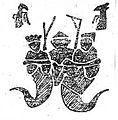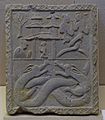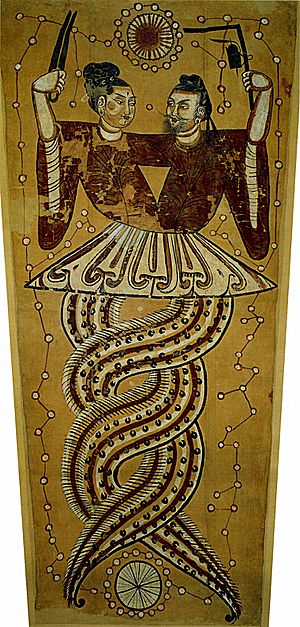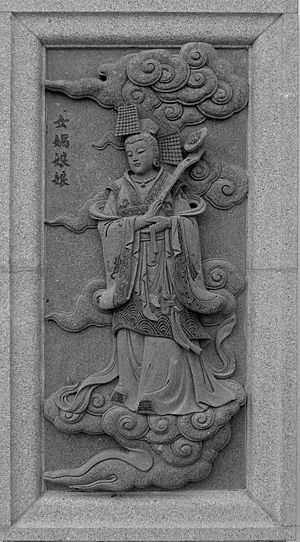Nüwa facts for kids
Quick facts for kids Nüwa |
|||||||||||||||||||||||||
|---|---|---|---|---|---|---|---|---|---|---|---|---|---|---|---|---|---|---|---|---|---|---|---|---|---|
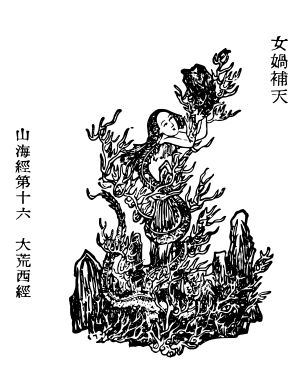
Nuwa repairing the pillar of heaven
|
|||||||||||||||||||||||||
| Traditional Chinese | 女媧 | ||||||||||||||||||||||||
| Simplified Chinese | 女娲 | ||||||||||||||||||||||||
|
|||||||||||||||||||||||||
Nüwa (pronounced Noo-wah) is a very important mother goddess in Chinese mythology. People say she created humans and fixed the sky after it broke.
According to the stories, Nüwa made the first humans from yellow clay. She carefully shaped the upper-class people by hand. But she got tired! So, she used a string to quickly pull up clay, making many more people. These became the lower-class.
The ancient book Huainanzi tells about a huge battle between gods. This battle broke the pillars that held up the sky! It caused terrible floods and chaos on Earth. Nüwa stepped in to save everyone. She patched the holes in the sky with five colorful stones. She also used the legs of a giant tortoise to fix the broken pillars.
Nüwa appears in many old Chinese stories about how the world began. Even today, she is a very important figure in Chinese culture.
Contents
What's in a Name?
The first part of her name, nü (Chinese: 女; lit. 'female'), is often used for goddesses. Her actual name is wa, sometimes read as gua (Chinese: 媧). This Chinese character is special and only used for her name.
Some people think wa might mean 'lovely'. Others suggest it could mean 'frog', which fits with her connection to water in some myths.
In Chinese, the word for 'whirlpool' is wo (Chinese: 渦). The word for 'snail' (Chinese: 蝸) sounds the same. Both these words use the character wa (Chinese: 咼). This character can mean 'spiral' or 'helix' (a twisted shape). It can also mean 'spin' or 'rotate'. This idea of spinning or twisting is sometimes shown in old paintings. Nüwa is seen holding a compass, which makes circles.
Her special, respectful name is Wahuang (Chinese: 媧皇; literally "Empress Wa"). This means 'Empress Wa'.
Nüwa's Great Deeds
The ancient text Huainanzi describes a time when the world was in big trouble. The four pillars holding up the sky were broken. The land was shattered. Fires burned everywhere, and huge floods covered the Earth. Wild animals attacked innocent people.
Nüwa decided to help. She melted five-colored stones to fix the blue sky. She cut off the legs of a giant turtle to use as new pillars. She also killed a black dragon, which was causing the floods. Then, she piled up reeds and ashes to stop the rising water.
After Nüwa's hard work, the sky was patched. The pillars were set up again. The floods went away, and the land became peaceful. Dangerous animals died off, and people were safe.
These disasters were said to be caused by a fight between two gods, Gonggong and Zhuanxu. The five colored stones Nüwa used represent the five Chinese elements: wood, fire, earth, metal, and water. The black dragon was linked to water and the floods. After fixing the world, Nüwa and Fuxi (another wise ruler) brought order to the land by following the right path, called the Way.
Other old writings also mention Nüwa's actions:
- The Classic of Mountains and Seas says Nüwa's insides turned into ten spirits.
- In Liezi, Nüwa fixes the sky with five-colored stones and uses tortoise legs as supports.
- Songs of Chu says Nüwa made people from yellow earth. She gave them life and the ability to have children. After demons broke the sky, she worked hard to fix it with melted stones.
- Shuowen Jiezi, an early Chinese dictionary, says Nüwa was both the sister and wife of Fuxi. An old painting from the Han Dynasty shows Nüwa and Fuxi with snake-like tails twisted together.
- Duyi Zhi tells a story about Nüwa and her older brother living on Mount K'un-lun. They were the only two people. They wanted to marry but felt shy. They prayed to Heaven, asking for misty vapor to gather if they should marry, or disperse if not. The vapor gathered, so they married. They used grass to make a fan to hide their faces. This is why people still use fans in weddings today.
- Siku Quanshu lists Nüwa as one of the Three August Ones, who were early, powerful leaders. She is listed with Fuxi and Shennong. Fuxi and Nüwa shared the same family name, Feng.
- Imperial Readings of the Taiping Era says that when the sky and earth first separated, there were no men. Nüwa made people from yellow clay. The clay wasn't strong enough, so she put ropes into the clay to make the bodies stand up. It also says she prayed to be the goddess of marriage.
Nüwa and Fuxi: A Special Pair
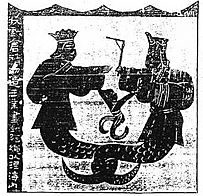
Nüwa and Fuxi are often shown together in old Chinese art. They usually have human faces or heads and snake-like bodies.
Sometimes they are shown as two separate figures facing each other. Other times, their snake-like bodies are twisted together. They often hold symbols like the sun (with a bird or three-legged crow inside) or the moon (with a toad or hare inside). Fuxi might hold a try square (a tool for making straight lines), and Nüwa might hold a compass (a tool for drawing circles). They might also hold a special mushroom called lingzhi, which means long life.
In some early Han dynasty art, Fuxi and Nüwa were separate. But later, during the middle of the Eastern Han dynasty, their tails started to intertwine.
In art from the Gansu region during the Wei and Western Jin periods, Fuxi often wears a "mountain-hat" (a three-peaked cap). Nüwa wears different hairstyles common for Han women. Both wear wide-sleeved clothes, showing the typical Han clothing style of that time.
Nüwa in Fengshen Yanyi
Nüwa also appears in the famous Ming dynasty novel Fengshen Bang. In this story, she is highly respected, sometimes called the "Snake Goddess."
One day, King Zhou of Shang visited Nüwa's temple. He saw her beautiful image and wrote a disrespectful poem on the wall. When Nüwa returned, she saw his words and became very angry. She swore that the Shang Dynasty would end because of his offense.
Nüwa tried to kill the king herself, but a powerful force stopped her. She realized that King Zhou was meant to rule for 26 more years. So, Nüwa called her three helpers: the Thousand-Year Vixen (who became Daji), the Jade Pipa, and the Nine-Headed Pheasant. She told them to go to King Zhou's palace and trick him. She warned them not to harm anyone else. If they did well, they would be reborn as humans.
After this, Nüwa was not heard from again in the story. But her actions indirectly led to the fall of the Shang Dynasty.
How Nüwa Created Humanity
Nüwa created humans because she felt lonely. She shaped the first people from yellow earth or clay. These first humans became the wealthy and important people in society. This was because Nüwa made them carefully with her own hands.
However, making everyone by hand took too much time and energy. So, Nüwa found a faster way. She dragged a string through mud, which created many more people at once. These became the majority of humanity. This story helps explain why there were different social classes in ancient China. The rich believed they were more important because Nüwa made them personally.
In another version of the story, Nüwa and Fuxi were the only survivors of a huge flood. The God of Heaven told them to marry. Nüwa gave birth to a ball of meat. They cut this ball into small pieces and scattered them across the world. These pieces then turned into humans.
Nüwa: The Arranger of Marriages
Nüwa was born three months after her brother, Fuxi. Later, she married him. Because of this, Nüwa is often given credit for inventing the idea of marriage itself.
Before they married, they lived on Mount K'un-lun. They felt shy about marrying each other. So, they prayed: "Oh Heaven, if you want us to be husband and wife, please make all the misty vapor gather. If not, make it disappear." The misty vapor gathered, showing they could marry.
When they became close, they wove grass to make a fan to cover their faces. This is why, even today, couples in some weddings hold a fan.
Nüwa and Fuxi together represent Yin and Yang. Fuxi is linked to Yang (masculine energy), and Nüwa is linked to Yin (feminine energy). Fuxi is often shown with a carpenter's square, which makes straight lines and represents the physical world. Nüwa is shown with a compass, which makes circles and represents the heavens and more abstract ideas. Their marriage symbolized the joining of heaven and Earth. Some stories say Nüwa invented the compass herself.
Nüwa Mends the Heavens: A Famous Story
The story of Nüwa Mends the Heavens (Chinese: 女娲補天; pinyin: Nǚwā bǔtiān) is very famous in Chinese culture. Nüwa's bravery and wisdom inspired ancient Chinese people to try and control nature. This story has become a favorite topic for Chinese poets, painters, and sculptors. You can find it in many novels, films, paintings, and sculptures, like those in Nanshan and Ya'an.
The Huainanzi tells how the four pillars supporting the sky suddenly broke. Other stories explain that this happened after a battle between the gods Gong Gong and Zhuanxu (or Zhu Rong). Gong Gong, angry about his defeat, crashed his head into Mount Buzhou, one of the sky pillars. This caused half of the sky to fall, creating a huge hole. The Earth also cracked, and its axis (the imaginary line it spins on) tilted towards the southeast. This is why western China is higher than eastern China, and most rivers flow southeast. It also explains why the sun, moon, and stars seem to move towards the northwest. Wildfires burned forests, and wild animals attacked people. Water poured from the Earth's cracks and wouldn't stop.
Nüwa felt sorry for the humans she had made. She decided to fix the sky. She gathered five colored stones (red, yellow, blue, black, and white) from a riverbed. She melted them and used the melted stone to patch up the sky. That's why clouds are colorful today! Then, she killed a giant turtle (named Ao in some versions). She cut off its four legs and used them as new pillars to hold up the sky. However, Nüwa couldn't make the legs perfectly equal, which is why the sky is still a little tilted.
After fixing the sky, Nüwa chased away the wild animals. She put out the fires and stopped the flood using a lot of ashes from burnt reeds. The world became peaceful again, just like before.
Empress Nüwa: An Early Ruler
Many Chinese people know about the Three Sovereigns and Five Emperors. These were early leaders and heroes in Chinese mythology. The lists of these rulers can be different depending on the source. One version includes Nüwa as one of the Three Sovereigns. She ruled after Fuxi and before Shennong.
The myth of the Three Sovereigns shows them as powerful, god-like figures. This story was used to show how important it was to have a strong ruler. Different versions of the story existed because China was often divided before the Qin and Han dynasties. The version with Fuxi, Shennong, and Nüwa helped emphasize order and structure.
In her time as a ruler, Nüwa fought against a neighboring tribal chief. She defeated him and took him to the top of a mountain. The chief was so ashamed that he crashed his head into a "heavenly bamboo." This act tore a hole in the sky and caused a flood that covered the whole world. Everyone died except Nüwa and her army, who were protected by her divine power. After that, Nüwa patched the sky with five colored stones until the flood went away.
Nüwa in Culture
- The famous novel Dream of the Red Chamber (1754) tells how Nüwa gathered 36,501 stones to patch the sky. She left one stone unused, and this stone plays a big part in the novel's story.
- A statue of Nüwa called Sky Patching was shown in Times Square, New York City, in 2012. It was there to celebrate Earth Day and remind people to protect the ozone layer. This statue is now in Vienna International Centre, Vienna.
- "Goddess Nuwa patches up the sky" (2013) is an app for iPhone and iPad.
- The story of Nüwa patching the sky was retold in a children's book by Carol Chen in 2014.
- The 2014 movie The Monkey King shows Nüwa (Zhang Zilin) sacrificing herself to repair heaven and create a gate to protect it from demons.
Images for kids
See also
 In Spanish: Nüwa para niños
In Spanish: Nüwa para niños


